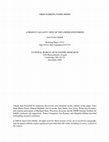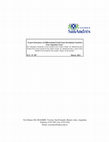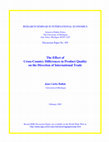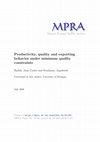Papers by Juan Carlos Hallak

Revista de economía política de Buenos Aires, Jun 6, 2023
A pesar de su abundancia de recursos naturales, la posibilidad de que Argentina logre un crecimie... more A pesar de su abundancia de recursos naturales, la posibilidad de que Argentina logre un crecimiento económico sostenido depende en gran medida de que pueda diversificar su estructura de exportaciones hacia bienes con mayor diferenciación y valor agregado. Sin embargo, los últimos 15 años no han mostrado avances en esa dirección. Las exportaciones reales (netas de precios) del país están estancadas y se concentran persistentemente en un reducido número de commodities, mientras que el número de exportadores es un tercio menor al de su máximo en 2006. Este se destacan la persistente inestabilidad macroeconómica y una política comercial fuertemente restrictiva. De todas formas, también es causa del estancamiento exportador la falta de una decidida orientación pro-exportadora de políticas, que permita aprovechar las oportunidades de inserción internacional a partir de una mayor diferenciación de producto que existen en el agro, la industria y los servicios basados en conocimiento. El trabajo desarrolla en profundidad el contenido de dicha orientación, considerando las políticas que lo componen y la necesidad de coordinar su implementación en el marco de estrategias sectoriales de inserción internacional. Palabras clave: Exportaciones argentinas, orientación exportadora, productos diferenciados, política productiva.
Social Science Research Network, 2009
The results in the paper have been screened to ensure that no confidential data are revealed. Res... more The results in the paper have been screened to ensure that no confidential data are revealed. Research results and conclusions expressed are those of the authors and do not necessarily reflect the views of the Census Bureau. We thank Carlo Altomonte,
International Journal of Industrial Organization, Feb 1, 2007
Social Science Research Network, Feb 1, 2008
We develop a method for decomposing countries' observed export prices into quality versus quality... more We develop a method for decomposing countries' observed export prices into quality versus quality-adjusted-price components using information contained in their trade balances. Holding observed export prices constant, countries with surpluses are inferred to offer higher quality than countries running deficits. Our method accounts for variation in trade balances induced by horizontal and vertical differentiation. We use our method to examine manufacturing product quality among the world's top exporters from 1989 to 2003. We find that the initial quality gap between high-and low-income countries is smaller than their initial income gap, and that the former narrows considerably faster over time.

A pesar de que la agenda de políticas vinculada a la internacionalización productiva cobra cada v... more A pesar de que la agenda de políticas vinculada a la internacionalización productiva cobra cada vez mayor relevancia, la experiencia de los países de América Latina en la implementación de las mismas ha sido mixta. Una de las razones que explica la gran cantidad de intervenciones fallidas o truncas es la falta de evaluación previa sobre la disponibilidad de capacidades estatales requeridas para cada política, así como de los costos y riesgos asociados. Sin embargo, no existe un marco conceptual que facilite el abordaje de dicha evaluación. Este trabajo realiza una contribución en ese sentido. Construimos una taxonomía de políticas de apoyo a la internacionalización productiva en términos de sus requerimientos de capacidades estatales, costos y riesgos. Luego, evaluamos la evidencia disponible sobre utilización e impactos de cada tipo de políticas en América Latina y su relación con las capacidades estatales disponibles en los países de la región. Sobre esta base, concluimos que es necesario rebalancear el portafolio de políticas vigentes hacia instrumentos que requieren capacidades más complejas (particularmente en la fase de su ciclo de vida que denominamos “operativa”), por lo que dicho rebalanceo debe ir de la mano de un esfuerzo por construir aquellas capacidades.
We estimate the effect of factor proportions on the pattern of manufacturing specialization in a ... more We estimate the effect of factor proportions on the pattern of manufacturing specialization in a cross-section of OECD countries, taking into account that factor accumulation responds to productivity. We show that the failure to control for productivity differences produces biased estimates. Our model explains 2/3 of the observed differences in the pattern of specialization between the poorest and richest OECD countries. However, because factor proportions and the pattern of specialization co-move in the development process, their strong empirical relationship is not sufficient to determine whether specialization is driven by factor proportions, or by other mechanisms also correlated with level of development.

RePEc: Research Papers in Economics, Mar 25, 2014
This study discusses four cases of public-private collaboration (PPC) in the design and implement... more This study discusses four cases of public-private collaboration (PPC) in the design and implementation of productive development policies (PDP) in Argentina. We find that PPCs have contributed to the success of most of the studied PDPs by facilitating information sharing and creating coordination devices that have improved the diffusion, transparency, and resilience of the policies and a more effective use of public funds. We also identify conditions that seem to be critical for a successful PPC. These conditions include the previous acquaintance and existence of trust relationships among the agents involved in the PPC, the alignment of their objectives and interests, and the emergence of clear leaderships in the private and/or in the public sectors. The stability of the PPCs, in turn, depends on the availability of public funding and the creation of formal governance mechanisms, while it is threatened by large disparities in the size, interests, and capabilities among the different private-sector agents involved in the collaboration.
Includes bibliographic references. "Latin American and Caribbean Microeconomic Report." 1. Agricu... more Includes bibliographic references. "Latin American and Caribbean Microeconomic Report." 1. Agricultural industries-Latin America. 2. Agricultural industries-Caribbean Area. 3. Agricultural productivity-Latin America. 4. Agricultural productivity-Caribbean Area. 5. Agriculture and state-Latin America. 6. Agriculture and state-Caribbean Area. 7. Sustainable development-Latin America. 8. Sustainable development-Caribbean Area. I.
The opinions expressed in this publication are those of the authors and do not necessarily reflec... more The opinions expressed in this publication are those of the authors and do not necessarily reflect the views of the Inter-American Development Bank, its Board of Directors, or the countries they represent. The unauthorized commercial use of Bank documents is prohibited and may be punishable under the Bank's policies and/or applicable laws. Copyright © 2012 Inter-American Development Bank. This working paper may be reproduced for any non-commercial purpose. It may also be reproduced in any academic journal indexed by the American Economic Association's EconLit, with previous consent by the Inter-American Development Bank (IDB), provided that the IDB is credited and that the author(s) receive no income from the publication. Cataloging-in-Publication data provided by the
provided excellent research assistantship. The views expressed herein are those of the author(s) ... more provided excellent research assistantship. The views expressed herein are those of the author(s) and do not necessarily reflect the views of the National Bureau of Economic Research. NBER working papers are circulated for discussion and comment purposes. They have not been peerreviewed or been subject to the review by the NBER Board of Directors that accompanies official NBER publications.

Economía
It is common to assess the evolution of a country’s export structure as a manifestation of the ex... more It is common to assess the evolution of a country’s export structure as a manifestation of the extent of progress or stagnation in its development process. Performing this exercise requires determining which features of exported products denote higher stages in that process. We argue that exports of differentiated products, especially when sold to developed countries, signal the acquisition of valuable knowledge that reflects development progress. We propose a new classification, denoted Micro-D, that works at the finest aggregation level in customs nomenclatures to provide a more precise identification of differentiated products. Specifically, the classification uses package size as a proxy for product differentiation to identify differentiated food and beverage exports. Thus, it is especially—though not exclusively—suited to capturing export upgrading in land-abundant developing countries. We apply the Micro-D classification to Argentina in 1998–2011 to deliver a new picture of th...
This paper evaluates how much of the economics profession has evaluated the evidence on the relat... more This paper evaluates how much of the economics profession has evaluated the evidence on the relationship between international trade and economic growth. The paper highlights the basic approaches to the trade and growth question that the literature has adopted. The case is made that more attention needs to be paid to the mechanisms by which trade impacts growth and that future research should move away from a focus on outcomes and look instead at these mechanisms.

The Linder hypothesis states that countries of similar income per capita should trade more intens... more The Linder hypothesis states that countries of similar income per capita should trade more intensely with one another. This hypothesis has attracted substantial research over decades, but the empirical evidence has failed to provide consistent support for it. This paper shows that the reason for the failure is the use of an inappropriate empirical benchmark, the gravity equation estimated using trade data aggregated across sectors. The paper builds a theoretical framework in which, as in Linder's theory, product quality plays the central role. A formal derivation of the Linder hypothesis is obtained, but this hypothesis is shown to hold only if it is formulated as a sector-level prediction. The "sectoral Linder hypothesis" is then estimated on a sample of 64 countries in 1995. The results support the prediction: after controlling for inter-sectoral determinants of trade, countries of similar per-capita income trade more intensely with one another. The paper also shows that a systematic aggregation bias explains the failure of the previous empirical literature to find support for Linder's theory.
This paper develops a methodology for decomposing crosscountry variation in export unit values in... more This paper develops a methodology for decomposing crosscountry variation in export unit values into quality versus real price components. The methodology is based on revealed preferences in an environment where consumers have a taste for variety. We derive conditions under which the unobserved export quality ratio of any two exporters is bounded by the observed Paasche and Laspeyres price indexes defined over their common exports to a third country. We then show that price variation not associated with variation in export product quality can be identified using information on countries' trade balance, and introduce a technique for adjusting the bounds to incorporate this information. Finally, we use our methodology to estimate the evolution of U.S. trading parter export quality from 1974 to 2001.

RePEc: Research Papers in Economics, Mar 1, 2011
This paper contains case studies documenting the process of export emergence in four sectors prod... more This paper contains case studies documenting the process of export emergence in four sectors producing differentiated goods in Argentina: wines, television programs, motorboats, and wooden furniture. Each case describes the development of Argentine exports, provides a basic history of the sector and shows the types of practices adopted by firms that were able to export to the developed world on a consistent basis. Since in all of the cases except wooden furniture export emergence in the sector is closely tied to the leading role of an export pioneer, the case studies also explain how the background of this export pioneer enabled him to gain the knowledge needed to export consistently. Finally, the cases characterize how the business practices first adopted by the pioneer diffused to other firms in the industry leading to export growth in the sector. 1 * A companion paper to Artopoulos A., Friel D., and Hallak J.C. (2011) "Lifting the Domestic Veil: Exporting Differentiated Goods across the Development Divide," NBER Working Paper No. 16947. We are especially grateful to Santiago Pérez for his enormous contribution to this paper as a research assistant. We also thank Alejandro Molnar and Gabriela Yu for their excellent research assistance and to Sebastián García Dastugue and Ezequiel Groisman for valuable comments. Juan Carlos Hallak acknowledges support from the NSF (Grant No. SES 0550190) and the ANPCyT (Grant No. 1643). 1 This paper provides a detailed description of each of the four case studies. We develop a conceptual framework based upon these cases in the companion paper.

RePEc: Research Papers in Economics, 2003
Despite considerable theoretical work predicting that product quality plays an important role in ... more Despite considerable theoretical work predicting that product quality plays an important role in determining the direction of international trade, there is no empirical evidence on the existence and magnitude of such a quality effect on trade. In this paper, I provide a framework to estimate the impact of crosscountry differences in product quality on bilateral trade flows. The model allows countries to differ both in the quality of goods they produce and in their aggregate demand for quality. It also takes into account other determinants of international trade, such as differences in factor proportions. I estimate the model using cross-sectional data on bilateral trade flows at the sectoral level. The empirical results confirm the theoretical prediction: rich countries import relatively more from countries that produce high-quality goods. Even though traditional determinants of comparative advantage are still the main driving force of trade, quality differences between countries have a significant effect on the pattern of international trade flows.

We develop a model of international trade with two sources of firm heterogeneity: "productivity" ... more We develop a model of international trade with two sources of firm heterogeneity: "productivity" and "caliber". Productivity is modeled as is standard in the literature. Caliber is the ability to produce quality using few fixed inputs. While there is no quality restriction to sell domestically, exporting requires the attainment of minimum quality levels. Compared to single-attribute models of firm heterogeneity emphasizing either productivity or the ability to produce quality, our model provides a more nuanced characterization of firms' export behavior. In particular, it explains the empirical fact that firm size is not monotonically related with export status; there are small firms that export while there are large firms that only operate in the domestic market. The model also delivers novel testable predictions. Conditional on size, exporters sell products of higher quality and at higher prices, they pay higher wages and use capital more intensively. We test these predictions using data on manufacturing establishments in India, the U.S., Chile, and Colombia. The empirical findings confirm the theoretical predictions.
Review of International Economics, Sep 9, 2021
This paper describes two Argentine case studies of firm's integration in global value chains ... more This paper describes two Argentine case studies of firm's integration in global value chains (GVCs) that target non‐mass market segments in developed countries. The cases involve a manufacturer of high‐end footwear and a manufacturer of customized automotive parts. Based on the common findings in these two cases, we build a conceptual framework that emphasizes relational links as an opportunity of GVC insertion for middle‐income countries that cannot buttress their international competitiveness on low wages. We call these modes of insertion manufacturing with co‐design.











Uploads
Papers by Juan Carlos Hallak